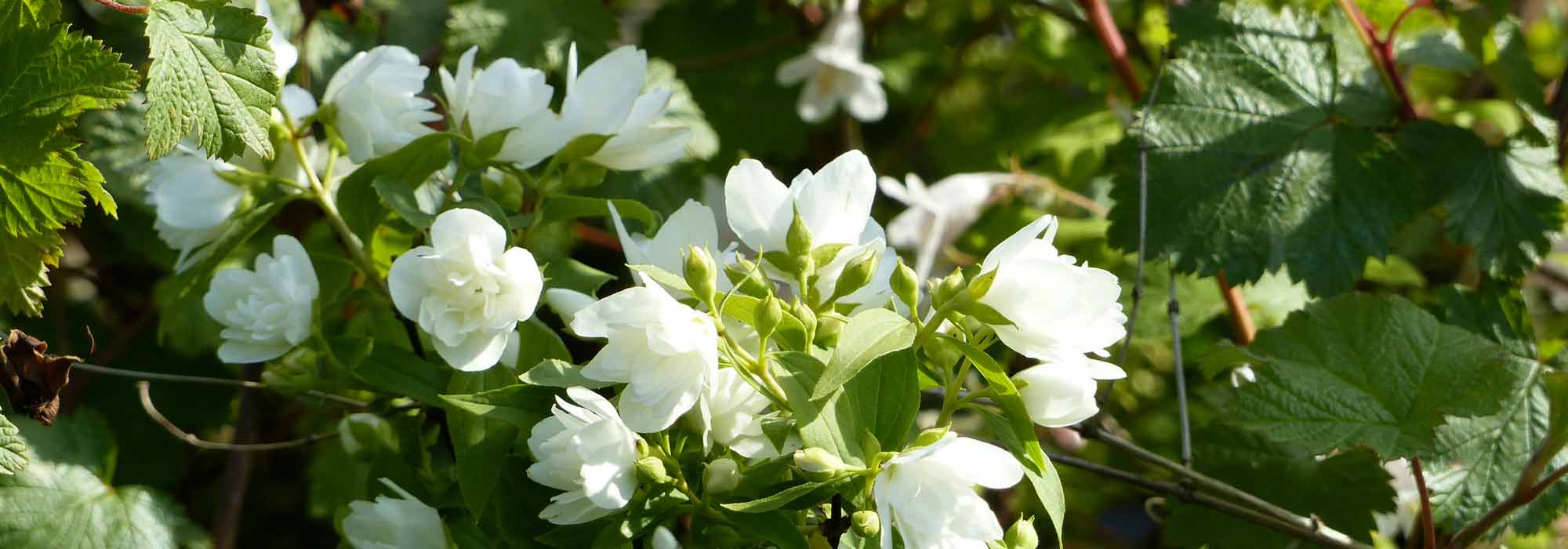
Mock orange, Philadelphus: planting, pruning and care
Contents
Mock orange in a nutshell
- Mock Orange is one of the most fragrant bushes in spring: it is a splendour when it is covered in cascades of intensely scented white flowers
- Its flowering fills the entire garden with fragrance in late spring or early summer
- Of variable size, it boasts beautiful green foliage or variegated gold
- Very hardy, never sick, Philadelphus thrives in any good garden soil and is almost foolproof!
- It is a must-have in white gardens, naturally finding its place in flowering hedges, as a specimen, as well as in large shrub borders and even in pots displayed on the terrace
A word from our expert
The Mock Orange, Philadelphus (in Latin), also known as “Poet’s Jasmine,” is one of the most beautiful spring-flowering bushes. Once quite popular but now somewhat forgotten, the Mock Orange, not to be confused with Syringa, which is the Latin name for lilac, is one of those nearly foolproof shrubs, undemanding and of exemplary frugality, that brings much satisfaction to gardeners, even beginners.
Adorned with its delicate, highly fragrant white flowers sometimes shyly tinged with pink, the Mock Orange fills the garden with its intense fragrance from May to July. Its abundant flowering lasts for a good three weeks, and once faded, it falls back into a certain ‘anonymity’, but what splendour when it disappears under an avalanche of immaculate white!
From Lemoine’s Mock Orange, undoubtedly the most fragrant of the scented mock oranges, to Philadelphus coronarius, the oldest of the mock oranges, including hybrids like Philadelphus x virginalis with double flowers, this shrub with beautiful non-evergreen green foliage, sometimes variegated with yellow or white, is highly valued for its great ease of cultivation.
Very hardy, this all-terrain shrub that adapts to any ordinary soil is not afraid of the cold and is as easy to grow as deutzias or spring weigelias. It is essential in a flowering hedge, as a specimen plant, as well as in large shrub borders. It can also be grown in a pot on the terrace or balcony.
Rediscover the mock oranges, these very accommodating, spectacular shrubs that are indispensable in every garden for their fragrance!
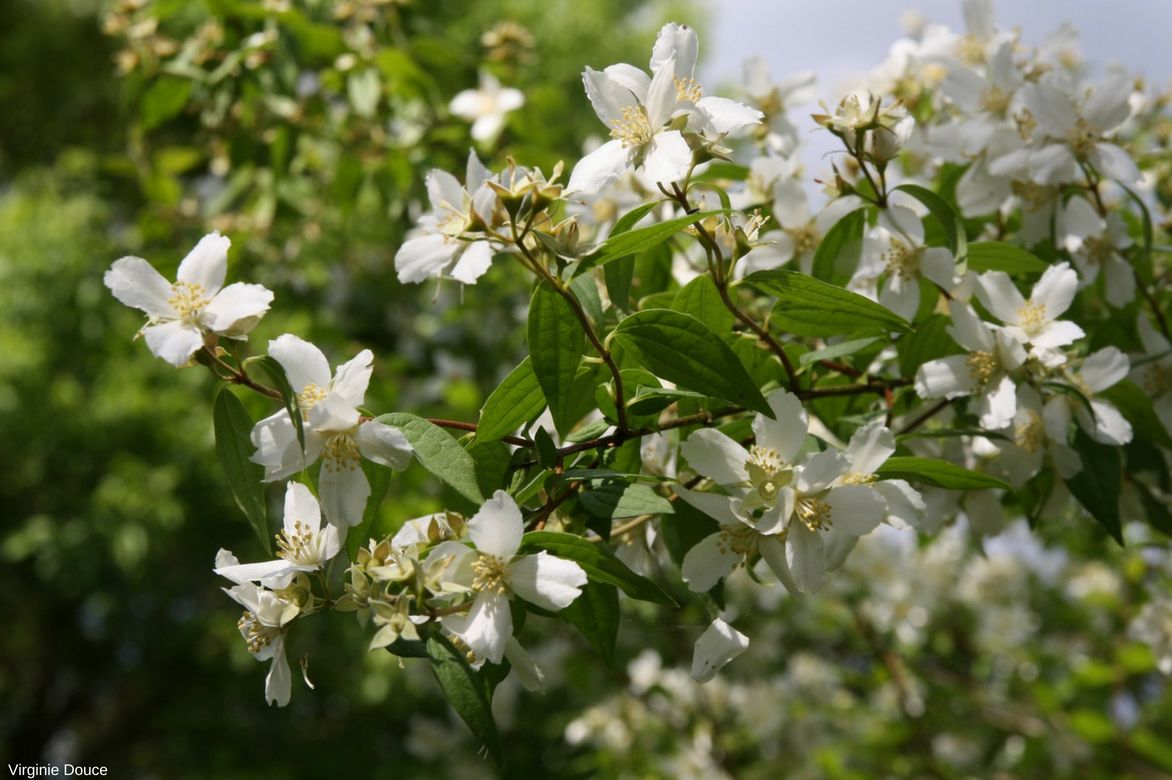
The immaculate flowers of Philadelphus coronarius emit an enchanting fragrance.
Description and Botany
Botanical data
- Latin name Philadelphus
- Family Hydrangeaceae
- Common name Mock Orange, Poet's Jasmine
- Flowering May to July
- Height 1.20 to 5 m
- Sun exposure Sun, partial shade
- Soil type All, well-drained
- Hardiness -20°-25°
The Mock Orange, also known as “Poet’s Jasmine” or Philadelphus in Latin, belongs to the Hydrangeaceae family, just like hydrangeas, and should not be confused with Syringa, which is the Latin name for Lilac and belongs to the Oleaceae family.
The genus Philadelphus comprises around forty species of bushes, native to the thickets and rocky hills of temperate regions in Europe and Asia. In our gardens, we mainly find cultivars of Philadelphus coronarius or “Garden Mock Orange”, a species cultivated for a long time, such as ‘Dame Blanche’ and ‘Belle Etoile’, as well as numerous hybrids with single or double flowers like Philadelphus x virginalis and Philadelphus x lemoinei.
With a medium to fast growth, the Mock Orange can grow 30 to 40 cm per year for the largest specimens and reach a height of between 1.20 and 5 m at maturity. It forms a bush that is almost as wide as it is tall. Some varieties, like ‘White Rock’, are truly compact and well-suited for small gardens and container cultivation.
It has a fairly good longevity of several decades. However, it is a bush that ages rather poorly, eventually becoming sparse and adopting, over time, a somewhat untidy silhouette, yet full of charm.
The shape and growth vary according to the cultivars and hybrids. The habit is bushy, rounded and spreading, sometimes erect or almost weeping with branches that are more or less trailing. Some cultivars display a lovely dome shape giving the bush a true white fountain appearance.
The branches contain a pith that was once hollowed out to make syringes, hence the name “Mock Orange”.

Flowers of Mock Oranges: Philadelphus coronarius, Philadelphus ‘Frosty Morn’ and Philadelphus ‘Belle étoile’.
In spring, deciduous leaves, simple, entire, ovate, elongated, with margins sometimes finely dentate, arranged in opposite pairs, appear measuring 2 to 10 cm. While they are most often bright green to dark green, some Mock Oranges have beautiful golden foliage (Philadelphus coronarius ‘Aureus’) or heavily speckled with golden yellow (‘Innocence’).
Some, like Philadelphus ‘Dame Blanche’, remain very decorative even after leaf fall with their beautiful brown bark that exfoliates over time.
The dense and deciduous foliage of the Mock Orange serves no other purpose than to frame the virginal beauty of the flowering. In the heart of spring, it disappears under an abundance of small white and fragrant flowers that envelop it like a mantle of ermine. They bloom in May-June, sometimes until July for the later cultivars, solitary, gathered in clusters or grouped in twos or threes in small bouquets at the tips of the year’s shoots or along the stems.
They are single, semi-double or double, depending on the varieties, with older varieties with single flowers like ‘Innocence’ generally being the most fragrant. They are cup-shaped, varying in width from 1 to 7 cm in diameter, composed of rounded pure white or cream petals, arranged around a heart of pale yellow to golden yellow stamens, sometimes absent, sometimes slightly washed with pink or pale purple.
These delicate corollas, so light, evoke in turn the flowers of gardenia or those of Deutzia, with which they are very close. However, they can be distinguished from the latter by their very pronounced fragrance. Indeed, there are rare scentless varieties, such as Philadelphus inodorus, but most Mock Oranges exude an intense and delightful fragrance, even more intense at the end of a warm spring day. It recalls the scent of orange blossom, wild strawberry, rose, or even neroli, hence the nickname given to the Mock Orange of “Poet’s Jasmine”.

Various foliage of Mock Oranges: Philadephus ‘Starbright’, Philadelphus coronarius ‘Aureus’ and Philadelphus ‘Innocence’.
The flowering branches will compose in spring delicate fresh bouquets. This nectariferous flowering, taking on the appearance of a cottony cloud, lasts no more than a few weeks but attracts pollinating insects.
Truly undemanding and very hardy (down to -15°C-20°C, sometimes beyond), the Philadelphus is a low-maintenance shrub, really easy to grow in ordinary soil, in sun or partial shade, making it a delight for beginner gardeners!
It finds its place in all gardens, even the smallest, and will shine in a large wildflower bed or in a small free-flowing and flowering hedge, along a path near the house, or even in a large container on the terrace or balcony to enjoy its fragrance.
Read also
How to prune early flowering bushesMain species and varieties
Syringas come in a great diversity of sizes, habits, and green or variegated foliage. Philadelphus coronarius is the most widespread species that once dominated gardens before being supplanted by Lemoine hybrids or American cultivars. It has given rise to many interesting cultivars from ‘Dame Blanche’ to ‘Belle Etoile’, as well as numerous hybrids with single or double flowers such as Philadelphus ‘Virginal’ and Philadelphus x lemoinei. Double-flowered hybrids are often less fragrant but more spectacular!
There are even very compact varieties (‘White Rock’) that are no taller than 1.25 m at maturity, all equally floriferous and fragrant, perfectly suited for small gardens and pot cultivation on a balcony or terrace.
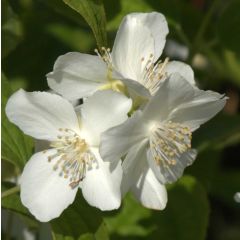
Philadelphus coronarius - Mock Orange
- Flowering time June, July
- Height at maturity 2,50 m

Philadelphus Belle Etoile - Mock Orange
- Flowering time July, August
- Height at maturity 2 m
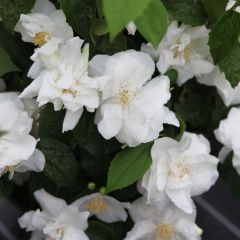
Philadelphus virginalis Natchez - Mock Orange
- Flowering time July, August
- Height at maturity 1,60 m
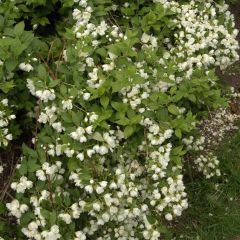
Philadelphus Manteau dHermine - Mock Orange
- Flowering time June, July
- Height at maturity 1 m
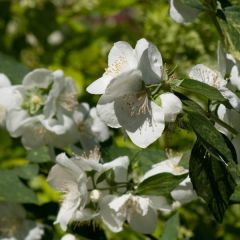
Philadelphus Innocence - Mock Orange
- Flowering time June, July
- Height at maturity 2,50 m
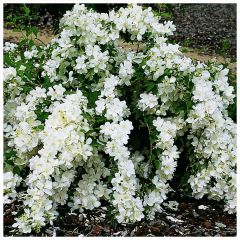
Philadelphus White Rock - Mock Orange
- Flowering time July, August
- Height at maturity 1,25 m
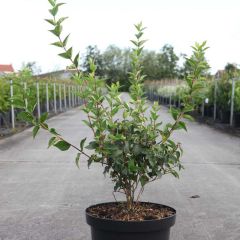
Philadelphus Dame Blanche - Mock Orange
- Flowering time July, August
- Height at maturity 1,30 m
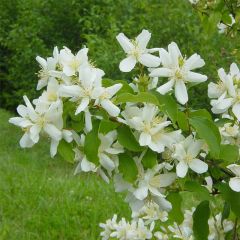
Philadelphus lemoinei - Mock Orange
- Flowering time July, August
- Height at maturity 1,50 m

Philadelphus Frosty Morn - Mock Orange
- Flowering time July, August
- Height at maturity 1,25 m
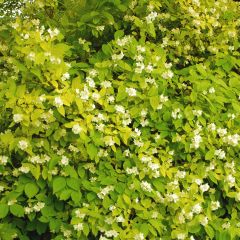
Philadelphus coronarius Aureus - Mock Orange
- Flowering time June, July
- Height at maturity 2 m
Discover other Philadelphus - Mock Orange
View all →Available in 3 sizes
Available in 2 sizes
Available in 4 sizes
Available in 2 sizes
Available in 1 sizes
Available in 1 sizes
Available in 1 sizes
Available in 2 sizes
Available in 2 sizes
Available in 1 sizes
Where, when, and how to plant a Philadelphus?
Where to plant?
Very hardy, the Seringat is not afraid of the cold, it easily withstands temperatures down to -25 °C without requiring a sheltered spot or special protection. Drought-resistant and disease-resistant, it adapts to all gardens and regions and can be grown in the ground as well as in pots.
Naturally accommodating, it is a versatile bush that accepts all types of soil, even poor and chalky ones, as long as it is well-drained. It tends to be more floriferous in fertile soil. While it tolerates dry soil in summer, it will be happier in soil that remains cool. However, it is sensitive to excess water in winter: avoid flooded areas.
It thrives in non-burning sunlight and accepts light shade, especially in regions with hot, dry summers; it easily tolerates competition from other bushes and large trees that provide beneficial shade. Too dense shade limits flowering. Varieties with variegated or golden foliage are more susceptible to scorching from intense sunlight, which may cause them to brown.
Versatile, it finds its place in naturalistic gardens, in a romantic garden, or even in a scented garden, where it will add a touch of elegance.
Some varieties do not exceed 1.25 m at maturity, making it a great choice for small gardens. Plan for a location suitable for the larger seringats, which can reach a span of 2.5 m quite quickly.
A wild garden is an ideal site where it will not need to undergo severe pruning. Be sure to surround it well, as once it has finished flowering, this delicate bush will fall into anonymity, only revealing itself in the beautiful season.
In a large garden, it can be planted in groups of 3 to enhance a large wildflower bed or a small free hedge with other spring-flowering shrubs, isolated on a short grass meadow, along a path of fragrant flowers, under a window near the house, or even in a large pot on the terrace to fully enjoy its fragrance.
When to plant?
Planting of the Philadelphus takes place from October to February, before or after the severe cold. To allow it to settle comfortably and avoid repeated watering during the first summer, autumn planting is preferable.
How to plant a Seringat?
In the ground
Feel free to group several seringats together for a spectacular effect. Large seringats are perfect for large-scale plantings in the wilder parts of the garden.
Maintain a planting distance of 50 cm to 1.50 m in all directions, depending on the varieties and the desired use: in a hedge, space the plants 50 cm to 1 m apart.
- After loosening the soil well, dig a hole at least three times wider than the root ball and at least 50 cm deep
- Backfill with the extracted soil mixed with coarse sand and a good handful of compost while keeping the bush upright
- Plant, keeping the collar slightly below soil level
- Firm the soil and optionally spread an organic mulch in warm regions to reduce watering in summer
- Water generously and regularly during the first year
Planting a Seringat in a pot
Choose small-growing varieties like ‘White Rock’ or ‘Dame Blanche’.
- Place your seringat in a large container of at least 30 to 40 cm in diameter
- Spread a layer of gravel or clay balls at the bottom of the pot
- Plant in a mixture of half good potting soil and half garden soil
- Mulch the base
- Water well during the growing season and whenever the soil is too dry
To learn more: Growing a Seringat in a pot.
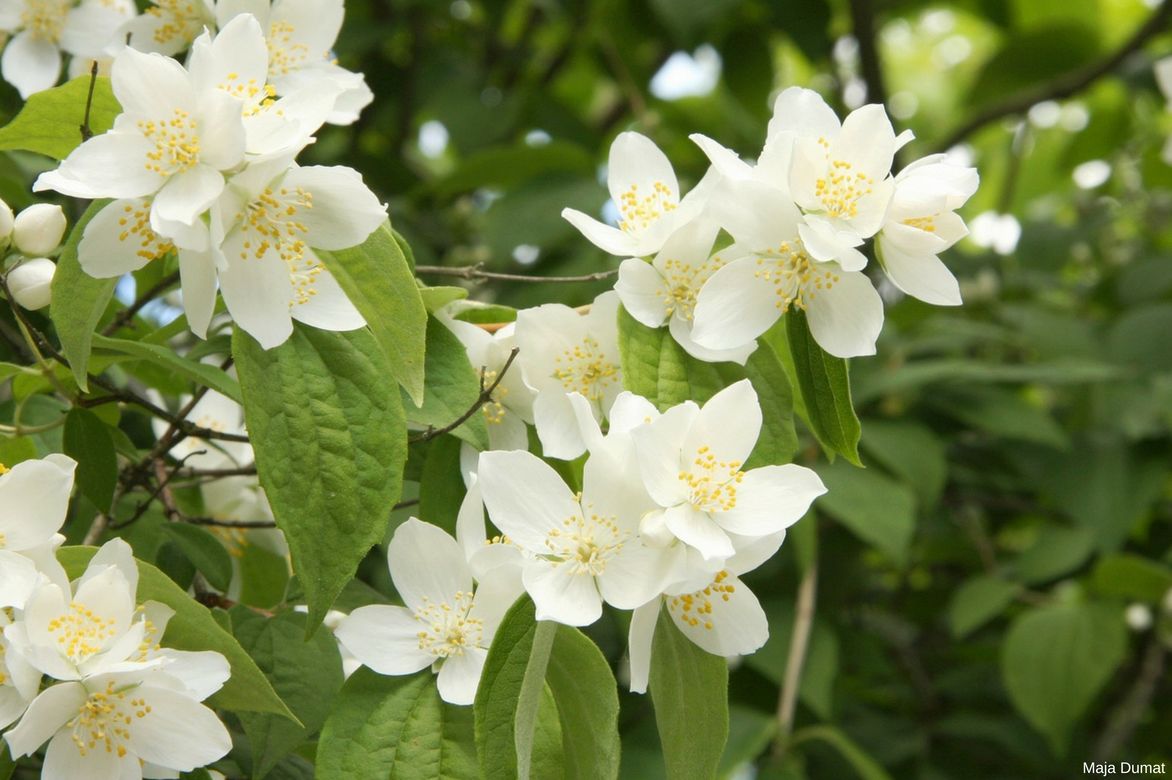
Philadelphus coronarius
Maintenance, pruning and care of the Philadelphus
In open ground
A well-established Philadelphus requires little care.
Mulch it and water it regularly every 15 days during the first two summers following planting to keep its roots cool.
You can allow the bush to develop freely without needing to prune it: just remove old wood and tangled stems to ensure that light can penetrate well into the heart of the branches.
Pruning is useful to thin the branches, restore a nice shape if it takes on a scruffy appearance, encourage it to branch from the base, and promote new abundant flowering. Prioritise the young stems produced from the stump by eliminating the old stems that hinder their development.
In any case, allow the Philadelphus to develop for two or three years before performing the first pruning. It is not necessary to intervene every year. After flowering, in July-August: shorten the withered branches by a third by cutting above a pair of leaves: you can optionally just trim the tips with hedge shears.
It is not afraid of being cut back hard; however, severe pruning will deprive it of flowers the following year. For older specimens that have become too bulky, cut back the old wood and the excessively long branches by half.
In pots
Water your Philadelphus as soon as the soil becomes dry twice a week in summer, as its water needs are greater than in open ground. You can also regularly apply fertiliser for flowering shrubs. Reduce watering and fertilisation in winter.
Diseases and potential pests
Very robust, the Mock Orange is rarely unwell. It can sometimes be prone to powdery mildew without the need for treatment and to black aphids against which you should spray a solution of soapy water.
Propagating Mock orange
The Mock Orange multiplies quite easily by propagation by cuttings of the branches. Take cuttings either from semi-woody branches, typically in August/September, or from woody cuttings of dry wood during the dormancy period, after the leaves have fallen, between November and February.
- Take tips of dry wood branches measuring 20 to 30 cm
- Plant them in a mixture of soil and river sand
- Overwinter in a sheltered spot, regularly moistening the cuttings
- Transplant in the following autumn directly in place or in pots
Discover our advice sheet: Propagating the Mock Orange.
Associating
With its abundant flowering, the Mock Orange brings a remarkable floral touch to the garden, even if it is short-lived!
It is precious for brightening up sunny or shady corners of the garden with a wild or more sophisticated note depending on the variety.
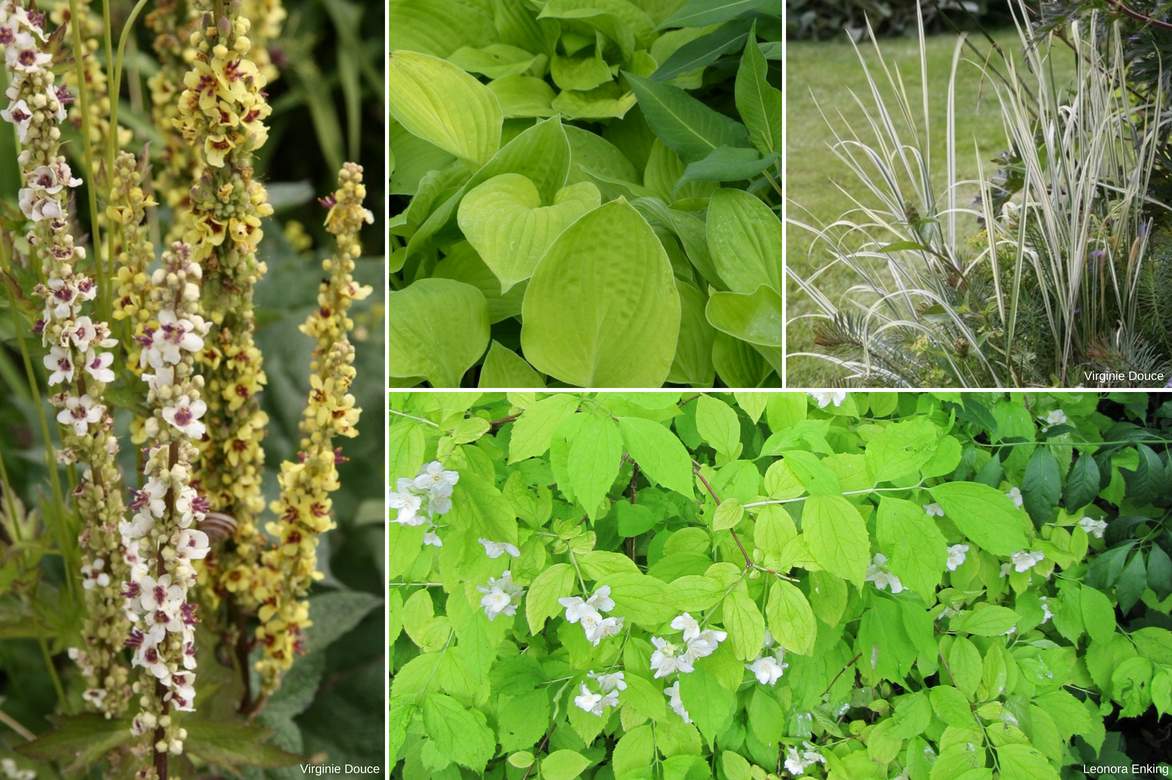
An idea for association: Philadelphus coronarius ‘Aureus’, Verbascum chaixii and ‘Cotswold Queen’, Hosta ‘August Moon’ and Holcus mollis ‘Albovariegatus’.
It is a must-have in a white garden alongside simple or double flowering roses, columbines, early flowering peonies, ornamental tobaccos, daffodil bulbs or late white tulips with which they create scenes of pure romanticism.
In a scented garden, it will be the ideal companion for old roses, Silverberry or a Mexican orange. Its virginal flowering also allows for beautiful associations in a white/blue garden with blue or purple flowering plants: plant a large carpet of pansies, campanulas, Caucasian forget-me-nots, Alpine columbines, and large garden irises at the foot of the Mock Orange.
Some Mock Orange flowers feature a centre tinged with pink at the base of the petals and will resonate with the pink flowers of a hardy geranium or pastel-toned columbines.
While it is dazzling in the beautiful season, this bush goes unnoticed in winter or when it is in leaf, hence the necessity to surround it well! Give it companions of staggered flowering shrubs such as Syringa vulgaris (lilac), Buddleia, Caryopteris or evergreen shrubs for an interesting hedge all year round, such as Dogwoods, Itea illicifolia, and Garrya elliptica.

An example of association in a flowering hedge where the bloomings succeed or overlap: Abelia grandiflora, Buddleia alterniflora, Philadelphus coronarius, Syringa meyeri ‘Palibin’, Garrya elliptica.
In a free or wildflower hedge, alternate it with other flowering shrubs such as Kolkwitzia, weigelias, Abelias, deutzias, Exochorda or Pearl Tree.
Later in the year, the larger deflowered Mock Oranges that have become a bit dull can be embraced by a light climber, honeysuckle, late flowering clematis or even climbing roses with early flowering.
The small varieties will be perfect mixed with other small shrubs such as spiraeas, dwarf weigelias, ground cover roses or even with hardy geraniums.
Useful resources
- Mock orange is essential in a romantic garden or in a white garden. Discover how to surround it properly!
- Find all our tips in a tutorial on how to plant mock orange well.
- Our buying guide: choose a mock orange.
- Subscribe!
- Contents
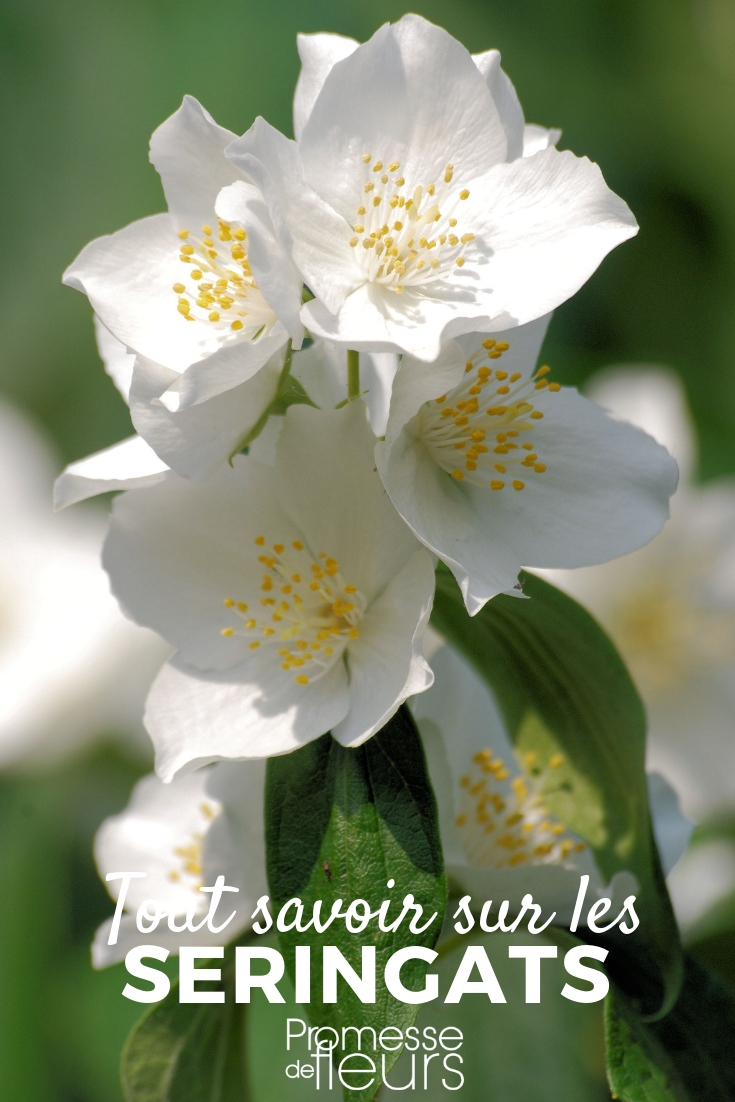







































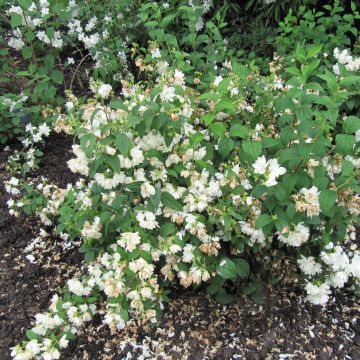

Comments